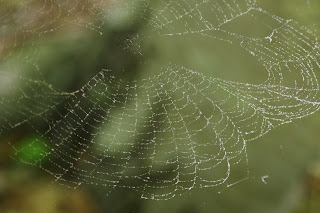Now, some frogs:
I tried looking all of these up, and wasn't terribly successful at finding good identifications, but this is a wood frog. We saw a lot of these today.
The next three might all be the same species, and that species might be American toad:
Backyard Bug of the Day:
Grasshopper. A nymph. I rarely see grasshoppers like this. I thought maybe this would be distinctive enough that it would be easy to look up what species it is, but that was not at all the case. So, all I can tell you is that it's a grasshopper nymph.
You probably can't judge how small it is from the picture, but I would say less than half an inch.
If you knew next to nothing about tree identification, even less than I do, you might possibly think that this is some kind of fruit growing on this tree. However, this is an oak tree, and oaks, as you probably do know, produce acorns, not fruits that look like this. While these were produced by the tree, they were caused by an insect; these are galls, which are growths that the tree creates, stimulated by an insect. The insect lays its eggs in the tissues of the tree, and the tree makes this (though not all galls look like this). Then the insect egg hatches and the larva develops inside the gall. These are oak apple galls, I think, and the insect that caused them is a tiny wasp called Amphibolips confluenta. These galls are probably a little over an inch in diameter. It's quite a spacious abode for a tiny wasp.
Sometimes I just want to take a picture of a flower...
Moth
Flies. The larger one is the female, I think.
Sweat bee
This looks like a bee, but it is a fly; a robber fly, I think. There is something very wrong with its wings. I don't know if it just emerged from pupation and the wings are not expanded yet–I don't really know about fly pupation–or if they are truly deformed. As you see it here, it is on a stick jutting out of the ground. It seemed to try to take off and fell to the ground.
I saw another one shortly after that was in much better shape, but since that one could fly, and fast, I didn't get a picture of it.
Arachnid Appreciation:
.
.
.
.
.
.
.
.
.
.
.
.
This is a trash spider. Guess why it is called that.
I found this abandoned web, covered with pollen. I imagine it to be very frustrating for spiders when something like this happens. With all that pollen stuck to the web, it probably becomes very ineffective for catching anything, with the stickiness covered in powder.

















No comments:
Post a Comment